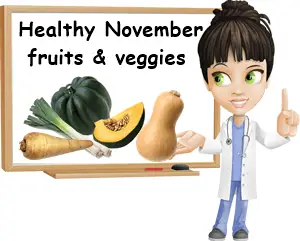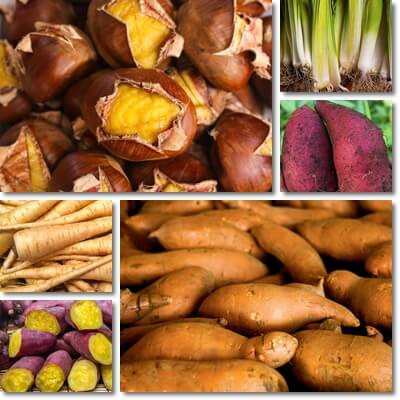What are some of the best foods you can eat in November? We are often under the impression that warm-season fruits and vegetables are the healthiest, but a lot of seasonal fall and winter foods are just as healthy, if not even healthier. November foods in particular are rich in essential vitamins and minerals, and a source of antioxidant, anti-inflammatory and anticancer benefits. Discover what are 9 of the best fruits and vegetables in season in November and what makes them good to eat.
Winter squashes
Despite their name, winter squashes are in full season in November. Edible winter squashes come in many shapes, sizes and colors, but are nonetheless nutritious, healthy options to consider for any meal. And they store well, lasting for months if kept in a cool, dark place. Winter squashes are good sources of potassium for high blood pressure, phosphorus for healthy bones and teeth, iron and B vitamins for anemia and fatigue, and dietary fiber to help combat and treat constipation. And here’s a tip: if the squash is edible, the seeds are edible too. Consider the butternut squash (Cucurbita moschata) for a nutritious cooking pumpkin, great for risotto, pumpkin cream soup or just for baking and eating as is.

Pumpkin
Pumpkin is the most recognizable species of winter squashes: large and roundish, with smooth, ribbed rind and deep orange rind and pulp. The colorful orange fruit is in season in November and one of the foods highest in carotenoid antioxidants. Pumpkin is rich in antioxidants with vitamin A activity such as beta-carotene, alpha-carotene and beta-cryptoxanthin. The pro-vitamin A antioxidants protect vision and contribute to immune system defenses.
In addition to the pulp and seeds, you can also eat pumpkin leaves, pumpkin flowers and pumpkin rind and enjoy many benefits for your health.
Sweet potatoes
While they can be cultivated year-round in some parts of the world, November throughout December is peak season for sweet potatoes. Choose from a range of beautiful colors such as yellow, purple, red, brown, beige or white sweet potatoes and the now standard orange sweet potato. Each color is indicative of different antioxidants with varied benefits for health. For instance, purple sweet potatoes are rich in anthocyanin antioxidants with scientifically proven anticancer properties. Whereas orange sweet potatoes are high in beta-carotene and other carotenoid antioxidants with benefits for eyesight.
Carrots
Fall-winter is peak season for the second major carrot harvest of the year (usually started at the end of summer). Just like sweet potatoes, carrots come in a variety of colors ranging from cream and yellow to orange, red and purple. Bicolor varieties also exist such as red carrots with a yellow core, purple carrots with a yellow or orange core etc. While purple carrots, also known as black carrots, are high in anthocyanins with scientifically proven anticancer properties, yellow carrots are high in xanthophylls such as lutein and zeaxanthin which studies show reduce risks of cataract and AMD (age-related macular degeneration or loss of vision).
Find out more about the benefits of yellow carrots.

Leek
Leek is in season roughly November throughout April, with November being peak season in the Northern hemisphere. Leek is more mild-tasting than onions, with subtle green flavor notes and light pungency. It is a generous source of iron and vitamins B6 and B9 which combat anemia and fatigue and boost vitality. Eating leek raw or minimally cooked, such as in an omelet, preserves its vitamin C content and boosts iron absorption.
Leek is an especially good food to eat in pregnancy because of its good content of iron, vitamin B6 and vitamin B9 which support the expanding circulatory system in pregnant women, contributing to the production of red blood cells which helps combat weakness and fatigue and boosts vitality. Vitamin B9 in leek is also good for the baby: vitamin B9 is scientifically proven to contribute to the normal development of the baby during pregnancy and reduce risks of neural tube defects of the brain, spine and spinal cord (e.g. spina bifida).
Turnip
November is a great month for turnips, although they are in season October throughout March in temperate and warm climates. Both turnip root and tops (aka turnip greens or turnip leaves) are edible and sources of important health benefits. Turnip root is very low in calories (22 kcal/100 g), making it aa good food to eat if you are looking to lose weight. The root is best eaten raw to preserve its vitamin C content and associated antioxidant, anti-inflammatory and antiaging benefits.
Turnip greens are much more nutritious than the roots. An extreme source of vitamin K at 350% of daily recommended intakes per 100 g, turnip tops boast anti-inflammatory benefits, contribute to strong healthy bones and a reduced risk of osteoporosis, and lower risks of cardiovascular disease by binding calcium to bones rather than soft tissues such as heart valves. Turnip tops are also high in vitamin C with antiaging and anti-inflammatory benefits and plant vitamin A with benefits for eyesight.
Parsnip
November is peak harvest season for parsnip, a cream-colored carrot-like root vegetable with a mild taste, but wonderful benefits for health. Studies show parsnip is a source of anticancer agents such as falcarinol, farcalindiol, methyl-falcarindiol and panaxydiol. Parsnip is a good source of potassium which helps bring down high blood pressure numbers, and contains good amounts of phosphorus for strong, healthy bones and teeth. Parsnip is even a good food to eat for pregnant women because of its generous vitamin B9 content which promotes the normal development of the baby during pregnancy and prevents neural tube defects of the brain, spine and spinal cord.
Cabbage
Cabbage is one of the absolute healthiest foods you can eat and it’s in full season October through November. Cabbage is a known anticancer food. Organic sulfur compounds known as glucosinolates (e.g. sulforaphane, Indole-3-carbinol) in cabbage have demonstrated anticancer activity against a number of cancers, including leukemia, colon and breast cancer. Raw cabbage provides generous amounts of vitamin C with antioxidant, anti-aging and anti-inflammatory properties. Cabbage is also high in vitamin K with benefits for bones and teeth and cardiovascular health.
Chestnuts
Chestnuts are in full season October through November and one of the best foods to eat. They are a great source of potassium and magnesium with benefits for high blood pressure and vitamins B1, B6 and B9 with benefits for muscle weakness and fatigue. Chestnuts are high in vitamin C with anti-inflammatory and immune system-boosting properties (note: cooking cuts vitamin C content in half). Chestnut flour is gluten-free and thus a great option for anyone with celiac disease or a sensitivity to gluten.
